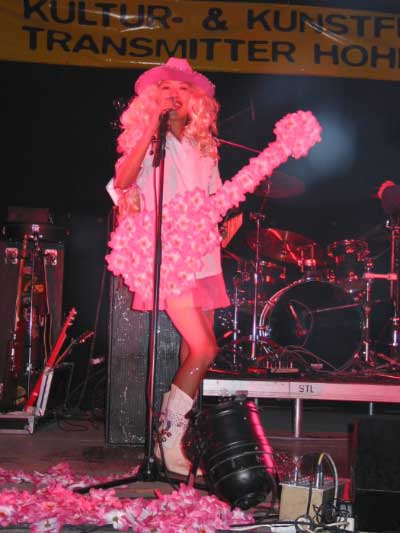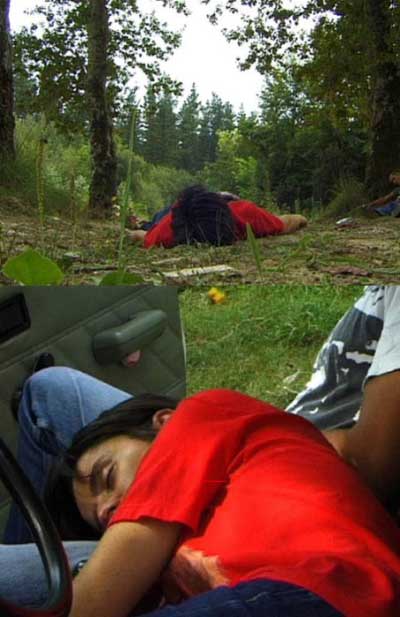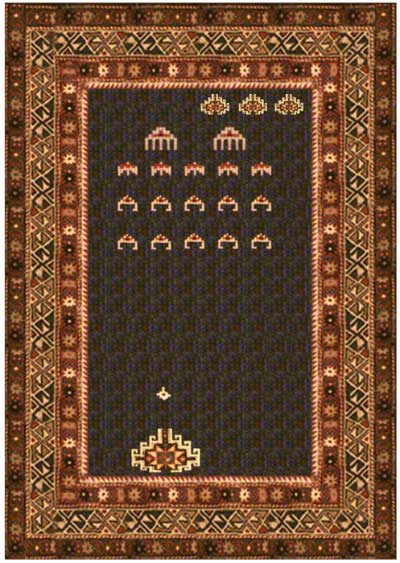THE
NANO-APPROACH TO BIG PROBLEMS
The Dis Location nano festival of contemporary attitude by 2020
Is there a single, direct way to tackle empty weekends and the boring
months in a capital city that has slept during the whole summertime?
During a short period of time, from the 23-29 of October, a festival was
organized out of a triple participation: Hsia-Fei Chang (Taiwan/France),
Jon Mikel Euba (Spain) and Janek Simon (Poland). Following the Re Location
Shake encounters in Luxembourg, Vlad Nanca invited and selected a group
of artists-friends coming from different backgrounds and offering different
attractions and distractions.
A lot of big events and festivals suffer under the grueling problems raised
by the overcrowded project lists and their unsatisfied wish to expand
into a city-wide web of locations or a vertical scale of multi-floored,
large-scale exhibitionism. The need to cover and fill out a supposedly
empty territory outweighs the instinct for managerial self-preservation.
The pressure for public acts of demonstrative force more often than not
ends in exhaustion and immediate loss of interest at the most important
moment of all – the time when you, yourself, the organizer, the
curator or the artist – can take a step back to see what really
happened and what else is there left to do.
Conscious or not, since its beginnings,
2020 was oriented by Vlad Nanca towards proximate needs or immediate ends.
It was always trying, at least in principle, to cut down on the need for
space, for more visibility and for financial aid. By placing the gallery
inside the home, Vlad ended up condensing the production and exhibition
place into one single unit, as well as opening up his home for a large
group of people labeled as visitors. Lobbying for a portable exhibition
was also part of this miniaturization process. In the face of dire needs
and nonexistent resources, viable solutions are overlooked for being too
simplistic and too easy going. That is why perhaps the pace of mini-galleries
following in the steps of the first examples has trickled to a stop.
At other times solution for continuous problems such as getting released
and promoted are quickly imitated since they appear as obvious or unique
in the way they handle those problems. But we should be concerned more
if examples lack imitators not when they do. As a powerful technological
trend, miniaturization has managed to attenuate the division of labor.
Multi-task division into separate sub-units was again made part of a single
independent tool. Miniaturization allowed us to carry around just one
such tool at a time. It allowed more control but also isolated its carriers.
The Dis Location nano-festival was again
able to show variety and to compete with bigger events hungering for budgets.
Huge budgets always getting postponed. The performance at the New Gallery
in Bucharest by Hsia-Fei Chang and the other two events by Jon Mikel Euba
and Janek Simon each at 2020 Home Gallery show a convergence towards mitigated
images and personal attitudes towards mass cultural standards.
All these performances necessitated a minimum of available resources,
and by happening one at a time and on different days, they all focused
the public’s attention separately and economically.
We always have to take into account the limited and easily dispersed energies
of a public with limited amounts of time, attention and interest.
Hsia-Fei Chang ‘live’ at Galeria Noua
The first of the three events was a performance.
Hsia-Fei Chang (Taiwan/France) has performed inside the Galeria Noua.
Whether it’s Hong Kong, Macao, Taiwan, Singapore, South Korea, Southern
mainland China or Japan they all have a peculiar way to build up and promote
`the idols'. These idols, as entirely artificial beings are highly controlled
entertainment end-products. Generally, they thread on a very narrow path
gracing a particular look and music style. Their career depends on keeping
up all these necessary conventions. They seem forever blocked in certain
postures and prefabricated personas with prefabricated biographies. Hsia-Fei
Chang’s performance at Galeria Noua was exhibiting all the trappings
of the idol-world and a way out from it. By exchanging and uniting several
performances into one, by playing between the live and the play-back;
the instant hit of the faceless glamour girl falls apart. The power of
the assembly line `idols' is always there; it is strident, mixing refinement
with vulgarity, and it shocks you because of the easy way it takes your
breath away. It is very hard not to see Hsia-Fei as the traveling Canton
pop star, and her wigs, silver shoes, and her purple silks all fit too
well…
Maybe that is why so many Bucharest eyes and cameras felt a kind of embarrassed
recognition as they watched and clicked, in their own drab and straight-faced
postures inside the Gallery.
Hsia-Fei manages to make you pick the pink plastic flowers from under
her feet(those lovely attendants Gontz and Cosma), sticking them on her
white cut-out guitar that was never meant to play a single disturbing
note. She reaches the teeny bopper in you, the screamer and the roadie,
makes you feel like the weary, tender-hearted clerk in the karaoke lounge
who just came in from his local fetish store. As a constant watcher you
want to keep all the props standing, you feel cheated if the magic stops,
or if the golden wig falls for the last time, or does it really matter
if the country western girl gets mixed up with the Shanghai diva and her
fantail?
Hsia-Fei offers you a heavily-perfumed glimpse on the same strange and
less than perfect world inhabited by the characters of Perfect Blue (*the
famous Japanese animation focusing on the idol industry and its victims).
Jon Mikel Euba
Jon Mikel Euba’s presentation was special as it was mostly art students who were there to learn about his art. The 2020 home gallery stood as comfortable place for a show case of the Basque artist’s projects. His photography, drawings and video works seem to be speaking about the shaky political and social situation in the Basque Country; however, ‘they do not celebrate fear and don’t encourage the public’s speculative expectations. They insist on the autonomy of their contemplative handicraft of repetition in the same measure as they construct a scenography of latent expectation.’
Janek Simon and his Carpet Invaders
During the Dis Location night, a motley
crew scoring for new art war games invaded the 2020 home Gallery. From
a beamer hooked on the ceiling, the magic ray spreads the magic
carpet on the living room floor. Janek Simon from Poland who used to launch
cathedral spires into space is preparing a comeback for classic arcade
games such as the one programmed and designed by Toshihiro Nishikado in
1978. From its beginnings this classic game dealt with political problems.
The initial human figures where swiftly transformed into pixilated, triangular
shaped, medusa-like, skull-headed extraterrestrials, so as to hide the
body counts and bloody scores.
Bible-belt communities felt terribly insecure after the tender minds of
their sons and daughters got hooked on the game, thus loosing their appetite
for Sunday school faith games. While coins got inserted, economical effects
where to follow, Japan was suffering a countrywide coin shortage and kids
in the States where busting the cash machines for small change. Cultural
upsurge was to follow.
Conflict areas always meet inside the 2-dimensional space of military
maps and game layouts.
Janek Simon unites the old geometric designs of Caucasian and Armenian
carpets with the low-resolution abstractness of the Space Invaders. The
collector carpet furnishing the ethnic-design, world-cuisine magazine
becomes a new shopping item for the homecoming marines and the kid back
home. It is the Oriental rug for your portable arcade mosque. Follow the
voice of the Joystick prophet.
Stefan Tiron
To see the festival
program please check www.2020.ro/dislocation
To
see images from Hsia Fei Chang’s performance please click here
To
see images from Jon Mikel Euba’s presentation please click here
To
see images from Janek Simon’s installation please click here
 |

|

|

|